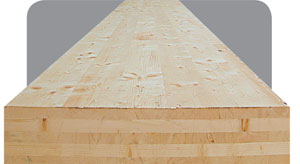Mass Timber and Wood Framing
Mass Timber Products and Systems
Advancements in wood technology, systems and products, together with performance-based building codes have fueled interest in building with mass timber in mid-rise construction and even taller buildings. Engineered wood products offer the architectural community alternate materials and systems with comparable or better performance and environmental attributes than other construction materials. Canadian architect Michael Green, in fact, sees mass timber—CLT, parallel strand lumber (PSL), and LVL—playing a major role in buildings up to 30 stories5. Performance-based building codes are accommodating the use of such new technology. While some of this new generation of wood products are not referred to specifically in the building code, architects can propose them as an alternative solution. As an example, buildings that were previously permitted only to be of non-combustible construction, can now be built of wood, provided it is sufficiently demonstrated that the structure provides equivalent fire safety.
Differentiated from dimensional lumber by having minimum dimensions required by the building code, modern mass timber6 refers to a family of products including sawn stress-grade lumber, timber tongue and groove decking, glulam, and CLT—that offer advantages in terms of increased strength, and also have quickened the construction process and enabled the use of wood products as solid walls, floors, elevator shafts, and columns to construct an entire building. Modern heavy timber products are particularly suited to mid-rise/multi-family housing, schools, large-span recreation centers, and supermarkets—buildings that must stand up to extreme loads caused by strong winds, heavy snow loads, and earthquakes.
 |
Panel sizes vary by manufacturer. CLT is currently available in North America with dimensions up to 19-1/2 inches thick, 18 feet wide and 98 feet long. Image courtesy of FPInnovations |
CLT is one type of new mass timber assembly that is comparable in strength to steel and concrete,7 but weighs less. A CLT panel has at least three glued layers of boards placed in orthogonally alternating orientation to the neighboring layers. In special configurations, consecutive layers may be placed in the same direction, giving a double layer to obtain specific structural capacities. Modern CLT exemplar include the eight-story H8 in Bad Aibling, Germany, which was completed in three weeks. Experts maintain that the structural performance of CLT makes it possible in situations where wood has never been used before.8 In North America CLT solutions are emerging in mid-rise buildings, setting records for versatility and speed.
Case Studies on Traditional and Innovative Wood Systems
The following case studies illustrate a variety of ways in which architects approach wood-frame mid-rise construction utilizing both traditional and new methods to maximize functionality. These examples cover a wide array of conditions and challenges, including cost, climate, seismic activity, and adherence to safety codes.









